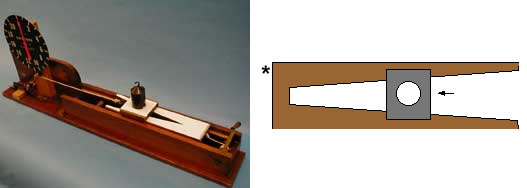Demos: 1K-01 Sliding Friction

A cord pulls a block across a surface and a scale displays the tension in the cord. Four aspects of the frictional force are demonstrated here.
(a) dependence on normal force (different weights)
(b) the static friction force being greater than the sliding friction force
(c) independence of area of contact (the fixed board has wedge cut out to vary the surface area*);
(d) the nature of the surfaces (blocks have different surfaces, depending on which side is down)
Directions: Pull the block slowly and point out that surfaces have small variations that cause the scale reading to fluctuate slightly; however, the reading remains fairly constant for each weight and surface configuration. By turning the block over, you can get Teflon surfaces having less friction.
Suggestions for Presentation: Ask what friction depends on. Most will know that the greater the weight, the greater the friction force, but will likely say also that the surface area is important. This comes from knowledge of things like race cars having wide slick tires. Show that in this setup the area doesn’t matter. As the block is pulled along, the surface area of contact becomes smaller and smaller, but the force doesn’t change. (The reason for wide slick tires is primarily to increase the surface area so that the heat can be dissipated more readily.)
Applications: The fact that sliding friction is less than static friction is important in braking. One can stop in a shorter distance if the brakes are just on the point of locking up, rather than skidding. ABS systems use this principle.
Last Updated: Nov 30, 2023 11:25 AM